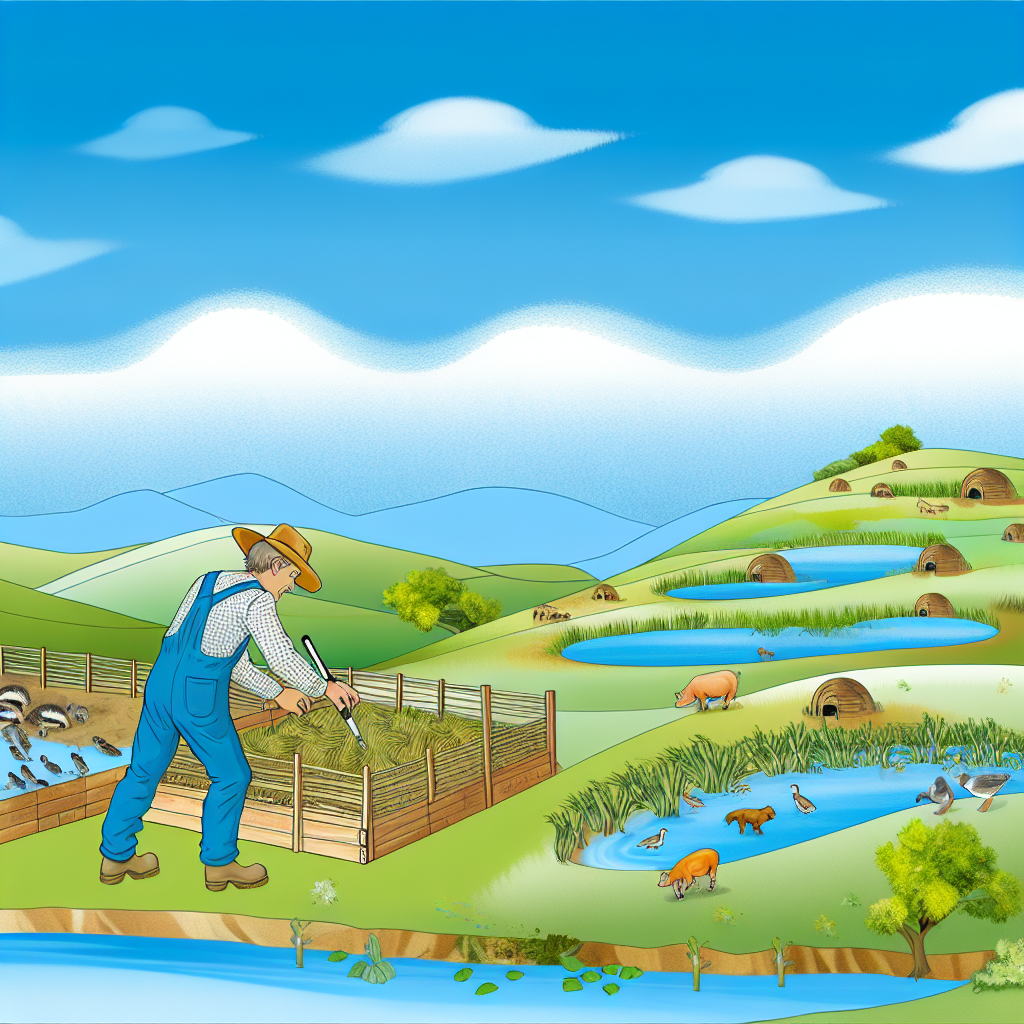Introduction to Farm Biodiversity and Its Importance
Farm biodiversity refers to the variety of life on farms.
This includes crops, livestock, insects, and microbial communities.
Incorporating biodiversity enhances the resilience of farming systems.
Moreover, it strengthens soil health and ecosystem services.
Benefits of Biodiversity on Farms
Biodiverse farms benefit from natural pest control.
Predators such as birds and beneficial insects reduce pest populations.
Furthermore, diverse plant varieties improve pollination rates.
This leads to higher yields and better-quality produce.
Promoting Soil Health
Diverse biological communities enrich the soil.
They enhance nutrient cycling and organic matter decomposition.
Consequently, this results in improved soil structure and fertility.
Healthier soil supports better crop growth.
Climate Resilience
Farm biodiversity increases resilience against climate change.
Variety in crops and livestock helps mitigate risks from extreme weather.
Farms can better adapt to droughts and floods through biodiversity.
Transform Your Agribusiness
Unlock your farm's potential with expert advice tailored to your needs. Get actionable steps that drive real results.
Get StartedThis adaptability is crucial for food security.
Supporting Ecosystem Functions
Biodiversity plays a key role in ecosystem stability.
It aids in water regulation, nutrient cycling, and pollination.
Healthy ecosystems provide essential services for agriculture.
Farmers benefit from reduced reliance on chemical inputs.
Understanding Different Types of Habitats in Farming
Importance of Habitats
Habitats play a crucial role in supporting farm biodiversity.
They provide essential resources for various species.
Each habitat type contributes uniquely to the ecosystem.
Additionally, diverse habitats can enhance agricultural productivity.
Types of Habitats in Farming
Farm habitats can be categorized into several types.
These include hedgerows, wetlands, and grasslands.
Each habitat type offers distinct benefits to the farm environment.
Hedgerows
Hedgerows serve as natural barriers on farms.
They protect crops from wind and erosion.
Moreover, hedgerows provide shelter for various wildlife.
This shelter bolsters pollinator populations, essential for crops.
Wetlands
Wetlands are vital for water management on farms.
They help filter pollutants and manage floodwater.
Additionally, wetlands support diverse plant and animal life.
These ecosystems foster habitats for aquatic species.
Grasslands
Grasslands offer a unique habitat for many farm species.
They support grazing animals crucial for agricultural systems.
Furthermore, grasslands improve soil health and carbon storage.
They enhance biodiversity by providing varied plant species.
Showcase Your Farming Business
Publish your professional farming services profile on our blog for a one-time fee of $200 and reach a dedicated audience of farmers and agribusiness owners.
Publish Your ProfileIntegrating Habitats into Farm Design
Farmers can integrate habitats into their farm design.
This integration supports both agriculture and biodiversity.
Farm layouts should prioritize natural habitat preservation.
This approach can lead to sustainable farming practices.
Strategies for Habitat Enhancement
- Plant native species that support local wildlife.
- Create buffer zones around sensitive areas like streams.
- Utilize cover crops to improve soil health.
- Encourage pollinator-friendly practices in crop management.
Ultimately, creating diverse habitats enhances farm resilience.
These efforts promote ecological health and sustainable agriculture.
Benefits of Enhancing Biodiversity on Farms
Improved Crop Yields
Enhancing biodiversity leads to higher crop yields.
More diverse plant species can improve pollinator interactions.
Healthy ecosystems boost resilience against pests and diseases.
Increased genetic variety helps crops adapt to changing conditions.
Soil Health and Fertility
Diverse organisms contribute to soil structure and fertility.
Earthworms and microbes enhance nutrient cycling.
Healthy soil supports robust plant growth.
Additionally, a varied ecosystem maintains soil moisture levels.
Pest and Disease Management
Biodiversity plays a crucial role in natural pest control.
Natural predators keep pest populations in check.
This reduces the need for chemical pesticides.
Furthermore, diverse plantings can disrupt pest life cycles.
Resilience to Climate Change
Increased biodiversity builds resilience to climate fluctuations.
Diverse ecosystems can better withstand extreme weather events.
For instance, varied crops can thrive under different conditions.
This adaptability ensures food security in uncertain times.
Enhanced Aesthetic and Recreational Value
A diverse farm landscape offers beauty and enjoyment.
Increasing biodiversity creates habitats for wildlife.
This attracts visitors and promotes local tourism.
Moreover, it fosters a connection between people and nature.
See Related Content: Reducing Farm Waste with Green Technologies
Strategies for Creating Pollinator Habitats
Choosing the Right Plants
Select native plants that attract local pollinators.
Consider flowering plants that bloom at different times.
This approach provides nectar throughout the growing season.
Use a variety of colors and shapes to appeal to diverse species.
Implementing Habitat Features
Create diverse habitat structures within the farm.
Incorporate patches of wildflowers and low-growing plants.
Leave some areas unmowed to encourage natural growth.
Install hedgerows to provide shelter and nesting sites.
Minimizing Pesticide Use
Reduce or eliminate pesticide use to protect pollinators.
Utilize organic farming practices whenever possible.
Implement integrated pest management techniques.
Educate farm workers on safe pesticide application methods.
Additional Resources and Tools
Provide educational resources to farmers about pollinator needs.
Showcase Your Farming Business
Publish your professional farming services profile on our blog for a one-time fee of $200 and reach a dedicated audience of farmers and agribusiness owners.
Publish Your ProfileCollaborate with local extension programs or conservation groups.
Utilize online resources for additional information.
Engage in community workshops focused on habitat creation.
You Might Also Like: Implement Crop Rotation for Eco-Friendly Farming
Incorporating Native Vegetation for Soil Health
Importance of Native Vegetation
Native vegetation enhances soil health significantly.
It provides essential nutrients to the soil ecosystem.
Moreover, native plants attract beneficial insects and pollinators.
These plants establish deep root systems, improving soil structure.
Benefits of Diverse Planting
Diverse planting fosters a balanced ecosystem.
It encourages a variety of microorganisms in the soil.
These microorganisms contribute to nutrient cycling.
Thus, they enhance overall soil fertility.
Selecting Appropriate Native Plants
Choosing the right native plants is crucial for success.
Consider local climate and soil conditions when selecting plants.
Popular choices include grasses, wildflowers, and legumes.
For instance, bee balm and echinacea are excellent options.
Establishing Native Vegetation
Establishing native vegetation starts with proper site preparation.
Clear any invasive species before planting native ones.
Follow this by sowing seeds or planting seedlings at the right time.
Additionally, monitor soil moisture levels during establishment.
Long-term Maintenance
Maintaining native vegetation ensures long-term benefits.
Regularly check for weeds that may compete with native plants.
Use controlled burns or mowing to manage overgrowth effectively.
Over time, these practices will promote healthy ecosystems.
Explore Further: Biodiversity’s Role in Soil Health
Utilizing Cover Crops to Promote Microbial Diversity
Introducing Cover Crops
Cover crops serve multiple ecological purposes in farming.
They shield the soil and enhance its health.
Moreover, they play a crucial role in promoting microbial diversity.
Benefits of Microbial Diversity
Microbial diversity improves soil structure and fertility.
Healthy microbes break down organic matter efficiently.
This process enriches the nutrient availability for plants.
Greater microbial diversity also enhances disease resistance in crops.
Choosing the Right Cover Crops
Selecting diverse cover crops is essential for optimal results.
Legumes, such as clover and vetch, fix nitrogen in the soil.
Additionally, brassicas like radishes improve soil aeration.
Mixing species can lead to synergistic benefits for soil health.
Implementing Cover Crop Strategies
Farmers can adopt various strategies for cover crop management.
Rotating cover crops each season promotes varied microbial communities.
Incorporating cover crops into crop rotations supports sustainable farming.
Monitoring Soil Health
Regularly testing soil health is vital for tracking success.
Showcase Your Farming Business
Publish your professional farming services profile on our blog for a one-time fee of $200 and reach a dedicated audience of farmers and agribusiness owners.
Publish Your ProfileFarmers should assess microbial populations and soil nutrients.
This data can drive adjustments in cover crop practices.
A Sustainable Approach
Utilizing cover crops fosters rich microbial ecosystems in farming.
As a result, farmers enhance resilience against pests and diseases.
This approach supports sustainable agriculture and food security.
See Related Content: Soil Moisture Conservation Tips for Farmers

Building Wetlands and Ponds to Support Aquatic Life
Importance of Wetlands and Ponds
Wetlands and ponds play a vital role in farm ecosystems.
They provide habitat for numerous aquatic species.
Furthermore, they help in nutrient cycling and water purification.
Creating Wetlands
Start by identifying suitable areas on your farm.
Look for low-lying areas that can retain water.
Consider soil types that can support wetland vegetation.
Next, dig shallow depressions to create basins.
These basins will hold water and attract wildlife.
Afterward, plant native aquatic plants to enhance biodiversity.
Designing Ponds
Ponds can complement existing habitats effectively.
First, choose a location that receives sufficient sunlight.
Ensure the pond has varying depths to support different species.
Include both sloped and steep banks for diverse habitat options.
Additionally, incorporate submerged structures like rocks or logs.
Management Practices
Regular monitoring is crucial for maintaining health.
Check water quality and aquatic plant growth regularly.
Control invasive species to protect native biodiversity.
Consider seasonal management techniques to enhance habitat quality.
Engaging the Community
Involve local schools and community groups in your efforts.
Organize volunteer days for planting and maintenance.
Encourage awareness of the importance of aquatic habitats.
Share your successes to inspire others in your region.
Collaborating with Local Conservation Groups for Biodiversity Projects
Importance of Collaboration
Collaboration enhances the effectiveness of biodiversity projects.
It brings together various expertise from different fields.
This teamwork generates innovative solutions to ecological challenges.
Identifying Local Partners
Identifying local conservation groups is the first step.
Organizations like the Green Earth Alliance work effectively in community engagement.
Another example is the Nature Conservation Society.
These groups often possess vital insights about local ecosystems.
Establishing Joint Goals
Establishing joint goals ensures everyone works towards a common objective.
Begin by assessing the specific biodiversity needs of the area.
Then, outline the desired outcomes for the projects.
This process fosters alignment between farmers and conservationists.
Engaging the Community
Engaging the community is crucial throughout the project.
Showcase Your Farming Business
Publish your professional farming services profile on our blog for a one-time fee of $200 and reach a dedicated audience of farmers and agribusiness owners.
Publish Your ProfileOrganize workshops and information sessions to raise awareness.
Encouraging community involvement helps build support and interest.
Furthermore, this engagement cultivates a sense of ownership among local residents.
Measuring Success
Measuring success is essential for understanding project impact.
Define clear metrics for assessing biodiversity improvements.
For instance, track changes in species populations or habitat quality.
Regular evaluations foster accountability and continual improvement.
Monitoring and Assessing Biodiversity Progress on Farms
The Importance of Monitoring
Monitoring biodiversity on farms is essential for sustainable practices.
It helps farmers understand ecological changes and trends.
Regular assessments enable timely interventions for biodiversity support.
Methods for Monitoring Biodiversity
Farmers can utilize various methods to monitor biodiversity effectively.
Field surveys offer practical insights into species presence and abundance.
Remote sensing technologies now provide innovative monitoring solutions.
Additionally, citizen science projects engage the community in data collection.
- Regular field surveys to assess plant and animal species.
- Camera traps for monitoring wildlife populations.
- Soil sampling to evaluate microbial diversity.
Setting Goals and Indicators
Establishing clear goals is vital for effective biodiversity monitoring.
Farmers should define specific indicators to measure success.
These indicators may include species richness and ecosystem health metrics.
Examples of Biodiversity Indicators
- Number of native plant species present.
- Population trends of key animal species.
- Soil organic matter content as an ecosystem health measure.
Creating a Biodiversity Action Plan
A comprehensive action plan helps track progress over time.
This plan should outline specific actions and monitoring timelines.
Farmers can review and adjust their strategies based on results.
Collaboration with local conservation organizations can enhance efforts.
Evaluating Progress
Regular evaluations are essential to understand biodiversity growth.
Comparing data over time reveals successes and areas needing attention.
Transparency in reporting can also encourage community support.
Sharing Success Stories
Celebrating achievements promotes ongoing commitment to biodiversity.
Farmers can share their results through workshops and social media.
Moreover, documenting case studies can inspire others in the farming community.




